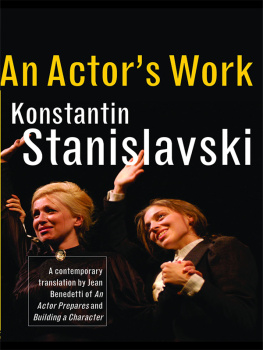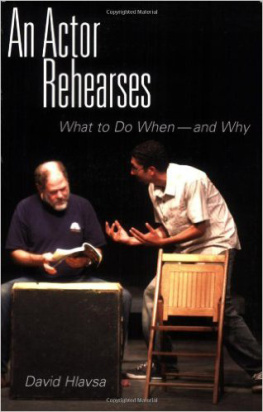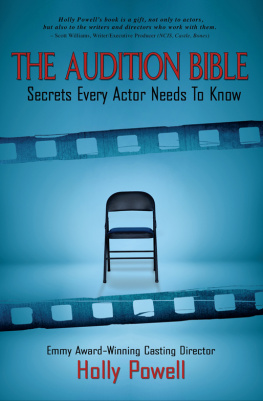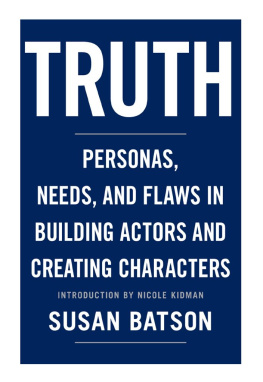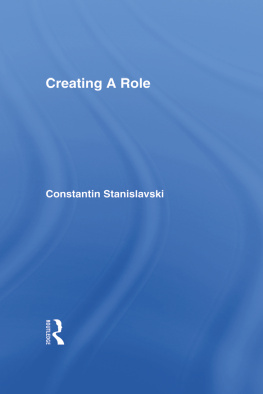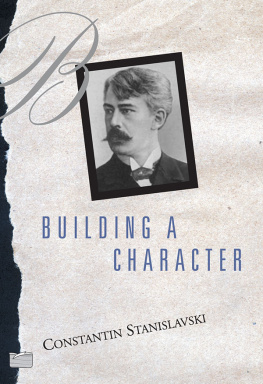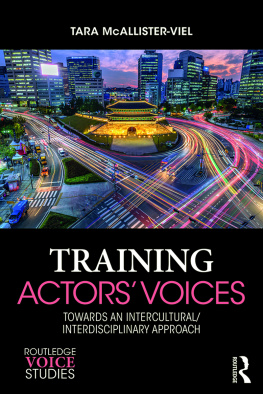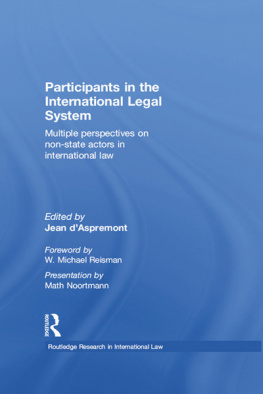An Actors Work
Stanislavskis system has dominated actor-training in the West since his writings were first translated into English in the 1920s and 30s. His systematic attempt to outline a psycho-physical technique for acting single-handedly revolutionized standards of acting in the theatre.
Until now, readers and students have had to contend with inaccurate, misleading and difficult-to-read English-language versions. Some of the mistranslations have resulted in profound distortions in the way his system has been interpreted and taught. At last, Jean Benedetti has succeeded in translating Stanislavskis huge manual into a lively, fascinating and accurate text in English. He has remained faithful to the authors original intentions, putting the two books previously known as An Actor Prepares and Building a Character back together into one volume, and in a colloquial and readable style for todays actors.
The result is a major contribution to the theatre, and a service to one of the great innovators of the twentieth century.
An Actors Work
A Students Diary
Konstantin Stanislavski
Translated and edited by Jean Benedetti
First published 2008
by Routledge
2 Park Square, Milton Park, Abingdon, Oxon, 0X14 4RN
Simultaneously published in the USA and Canada
by Routledge
270 Madison Ave, New York, NY 10016
This edition published in the Taylor & Francis e-Library, 2007.
To purchase your own copy of this or any of Taylor & Francis or Routledges collection of thousands of eBooks please go to www.eBookstore.tandf.co.uk.
Routledge is an imprint of the Taylor & Francis Group, an informa business
Translation, text and Afterword 2008 Routledge
Translators Foreword and editorial matter 2008 Jean Benedetti
Introduction 2008 Declan Donnellan
All rights reserved. No part of this book may be reprinted or reproduced or utilized in any form or by any electronic, mechanical, or other means, now known or hereafter invented, including photocopying and recording, or in any information storage or retrieval system, without permission in writing from the publishers.
British Library Cataloguing in Publication Data
A catalogue record for this book is available from the British Library
Library of Congress Cataloging-in-Publication Data
Stanislavsky, Konstantin, 18631938.
[Rabota aktera nad soboi. English]
An actors work : a students diary / Konstantin Stanislavski ; translated and edited by Jean Benedetti.
p. cm.
Includes bibliographical references and index.
1. Method (Acting) I. Benedetti, Jean. II. Title.
PN2062.S7613 2008
792.028dc22
2007045357
ISBN 0-203-93615-9 Master e-book ISBN
ISBN 10: 0-415-42223-X (hbk)
ISBN 10: 0-203-93615-9 (ebk)
ISBN 13: 978-0-415-42223-9 (hbk)
ISBN 13: 978-0-203-93615-3 (ebk)
To Maria Petrovna Lilina, who has shared my labours, my best teacher, beloved actress, ever devoted help-meet in all my theatrical endeavours, this book is dedicated.
INTRODUCTION
Declan Donnellan
The best Stanislavski story I know isnt about an actor at all but about a dog. An actor had a dog. This dog used to come to rehearsals and, being rather lazy, would sleep in the corner all day long. Strangely, every evening, just before the actors were to finish, the dog would already be at the door, leash in mouth, waiting to be taken home. What astounded Stanislavski was that the dog would wearily haul himself to his feet several minutes before his master called him. Regular as clockwork, come the end of every rehearsal, the dog would trot to the door and wait there patiently. Now how could a dog possibly know that the rehearsal was over before anyone moved to the door? Finally Stanislavski figured it out. The dog could hear when the actors started talking like normal human beings again. The difference between the fake and the living was just as sharp as Pavlovs bell.
Stanislavski was obsessed with life. When he uses the word art it often reads as a code for life. This fusion is clear even in the title of his autobiography My Life in Art. His absolute priority was that the stage should flow with life. He hated empty effects and loved genuine vitality. He abhorred hollow gestures that pretend to breathe. He sought that curious mixture of discipline and spontaneity that characterises all good art.
Presumably this is why he continues to inspire us. His own inspiration he drew from many sources. As a young man he was particularly impressed by the ensemble style of a German company on tour in Moscow, and also by Eleanora Duse, the great Italian star who seemed to efface her virtuosity in a struggle for the living moment. But of course he drew most of his inspiration from the life he saw ebbing and flowing around him.
In the first place, Stanislavski had a vision of a living theatre, a theatre that was not only a building or even a company, but a whole attitude to theatre itself.
Then the question he had to ask was: How can I do this? How can I make life flow on stage?
This is normally the moment when we all speed on to find out how he answered the question. What do I need to do, what exercises can I practice, to become a successful actor? Just show me the steps and Ill follow the plan! But it is precisely here that we need to slow right down. We need to remember what it is that Stanislavski first saw. Stanislavski saw, or had a vision of, a form of acting that brimmed with life. To his consternation he realised that the line between the sham and the authentic can be very narrow. Yes we can immediately see the gulf that seems to separate the terrible old ham from the sophisticated naturalism of the modern film star. But the sham often seems very real and the most perfectly natural performance can also be perfectly fake. In fact separating appearance from reality is one of our toughest struggles and being clever can make it harder. Sometimes it takes a dog to tell the difference.
Stanislavski saw that it is easier to give the audience a clever ride than a real experience. But his fundamental intuition was that acting is more than seeming to be real. Above all, he knew that acting and pretending are utterly different and that the distinction is both subtle and crucial. In a way, all his work helps to explain that difference.
And somehow that first intuition of Stanislavski can get squashed in our acceleration to learn the techniques and devices that he invented (and frequently discarded). The first step is not to ask How can I be a successful actor? The first question must always be What is good acting? And the answer will remain the same: When it is alive. Strangely we need to keep returning to this point of departure, otherwise we are forever lost.
A few days ago a foreigner approached me in the street and inquired in precise English: Excuse me please, but which way is Belsize Park? When I answered he looked at me carefully and asked with great emphasis: But how will I recognise it when I get there? It was a very good question. Learning to recognise when we get there is of vital importance in every field.
Learning to recognise things is of great importance to Stanislavski, for example, the actor must learn to see the constraints imposed on the character. Stanislavski gives great importance to the Given Circumstances. The idea seems so obvious and yet it is so subtle. He understands that life is only possible within a context. That character and action are all dependent on the Given Circumstances, that we need to see the tiny realities that make up the world we live in. Our species is painfully learning that its very survival depends on the health of the planet. We cannot exist in a vacuum.

